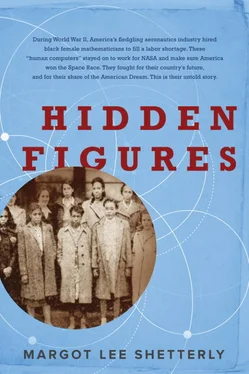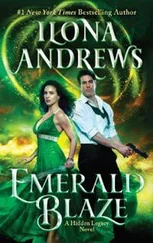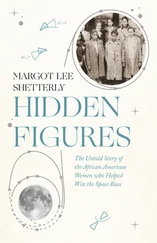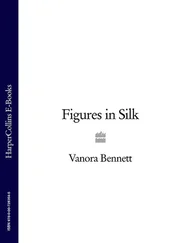It would no sooner have occurred to her that a place with so baroque a name as the Langley Memorial Aeronautical Laboratory would solicit an application from Negro women than that the white women at the college across the street would beckon her through the front doors of their manicured enclave. Black newspapers, however, worked indefatigably to spread the word far and wide about available war jobs and exhorted their readers to apply. Some were dubbing Executive Order 8802 and the Fair Employment Practices Committee “the most significant move on the part of the Government since the Emancipation Proclamation.” Dorothy’s own sister-in-law had moved to Washington to take a job in the War Department.
In the first week of May 1943, the Norfolk Journal and Guide published an article that would call to Dorothy like a signpost for the road not taken. “Paving the Way for Women Engineers,” read the headline. The accompanying photo showed eleven well-dressed Negro women in front of Hampton Institute’s Bemis Laboratory, graduates of Engineering for Women, a war training class. Founded in 1868, Hampton Institute had grown out of the classes held by the free Negro teacher Mary Peake, in the shade of a majestic tree known as the Emancipation Oak. On the eve of World War II, Hampton was one of the leading Negro colleges in the country and the focal point of the black community’s participation in the conflict.
The women had come from points up and down the East Coast, and from right there in town. Pearl Bassette, one of several Hampton natives, was the daughter of a well-known black lawyer, her family tracing its roots back to the early days of the city. Ophelia Taylor, originally from Georgia, graduated from Hampton Institute, and prior to starting the class was running a nursery school. Mary Cherry came from North Carolina, Minnie McGraw from South Carolina, Madelon Glenn from faraway Connecticut. Miriam Mann, a tiny firebrand who had taught school in Georgia, had come to the city with her family when her husband, William, accepted a position as an instructor teaching machine shop at the US Naval Training School at Hampton Institute.
There were black jobs, and there were good black jobs. Sorting in the laundry, making beds in white folks’ houses, stemming in the tobacco plant—those were black jobs. Owning a barbershop or a funeral home, working in the post office, or riding the rails as a Pullman porter— those were good black jobs. Teacher, preacher, doctor, lawyer—now those were very good black jobs, bringing stability and the esteem that accompanied formal training.
But the job at the aeronautical laboratory was something new, something so unusual it hadn’t yet entered the collective dreams. Not even the long-stalled plan to equalize Negro teachers’ salaries with those of their white counterparts could beat this opportunity. Even if the war ended in six months or a year, a much higher salary even for that brief time would bring Dorothy that much closer to assuring her children’s future.
So that spring, Dorothy Vaughan carefully filled out and mailed two job applications: one to work at Camp Pickett, where the need for labor was so great, so undifferentiated, that there was virtually no possibility that they would not hire her. The other, much longer application reviewed her qualifications in detail. Work history. Personal references. Schools attended: high school and college. Courses taken, grades received. Languages spoken (French, which she had studied at Wilberforce). Foreign travels (None). Would you be willing to accept a position abroad? (No). Would you be willing to accept a position in Washington, DC? (Yes). How soon could you be ready to start work? She knew the answer before her fingers carved it into the blank: 48 hours, she wrote. I can be ready to go within forty-eight hours.
CHAPTER THREE
Past Is Prologue
The 1943 school year at Farmville’s Robert Russa Moton High School started the same way other years always had: same space, more students. The “new” high school, built in 1939 to accommodate 180 students, had been obsolete almost from its beginning. In the school’s first year of operation, 167 students arrived for classes. Four years later, Dorothy Vaughan and her twelve fellow teachers were welcoming 301 education-hungry youngsters, urged along by parents who wanted more for their children than a life of work in the tobacco factories. The students walked for miles to get to the school or took their chances each morning in barely roadworthy buses that made the rounds in the outer reaches of Prince Edward County.
As a member of Moton’s parent-teacher association and a founding board member of the Farmville chapter of the NAACP, Dorothy worked hard to improve the long-term educational prospects of the young people of Farmville. As a teacher, her ambitions were more immediate: with only eight classrooms; no gymnasium, lockers, or cafeteria; and an auditorium outfitted with folding chairs, it took all her leadership and creativity to maintain an orderly learning environment. Somehow, she managed to impart the finer points of arithmetic and algebra in the auditorium, with two other classes taking place simultaneously. The school building might have been modest, but Dorothy’s standards were not. She once discovered an error in one of the math textbooks she used in her classroom and dashed off a letter to the publisher informing them of their mistake (they fixed it, and sent her a thank-you letter in return). The Good Lord himself might have squirmed in his seat if Mrs. Vaughan had caught Him out in her class without having done His algebra homework. She devoted time after the end of the school day to tutoring students who required extra help. She also worked with the school choir; under her direction, several of Moton’s vocal quartets had come away victorious in statewide music competitions. In 1935, a Norfolk Journal and Guide article covering the annual event dubbed her “the festival’s most enthusiastic and hardest working director.” In 1943, she and the school’s music teacher, Altona Johns, put students through their paces in preparation for the year’s Christmas cantata, “The Light Still Shines.”
The feverish summer gave way to fall foliage and brisk mornings, but routines had changed to accommodate the war. The school’s 4-H club made care packages for departing servicemen and hosted a community discussion entitled “What Can We Do to Win the War?” The Moton school office put war stamps on sale, each purchase a small offset against the gargantuan cost of the military production. The community held going-away parties and prepared feasts for the young men heading off to the front. Dorothy updated her classes with a unit called Wartime Mathematics, teaching students to apply arithmetic operations to household budgeting and wartime ration books and updating classic word problems with airplanes instead of cars.
Sometimes, it seemed as if Dorothy had never been without Farmville or Farmville without her. The town had embraced her with the warmth accorded a native daughter; she had called it home longer than any other place she’d lived in in her thirty-two years. Her life, however, was a model of America’s great love affair with mobility, in every sense. In moments of deepest reflection, as she waited for a response to her application for the job in Hampton, Dorothy might have detected the quickening of something beyond the pragmatic hope for economic advancement, the reigniting of restless embers long quiet in the twelve years since she had come to Farmville.
Paper resolve was one thing, the messiness of real life another. She was no longer a single student with an itinerant soul but a wife and mother of four children. The job at Langley was a full-time position and required a six-day workweek at an office too far away to come home on weekends, as she had done during the summer at Camp Pickett. And yet, when the half-forgotten, hoped-for letter finally arrived, she had already made up her mind. Once Dorothy made up her mind, no one—not her husband, not her in-laws, not the principal at Moton—would be able to dissuade her from her goal.
Читать дальше
Конец ознакомительного отрывка
Купить книгу












